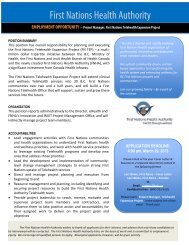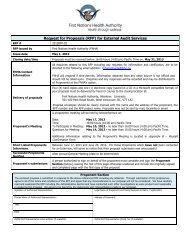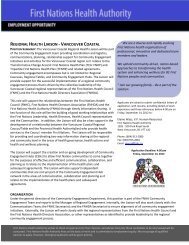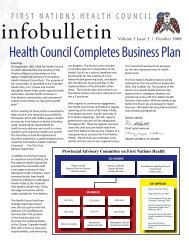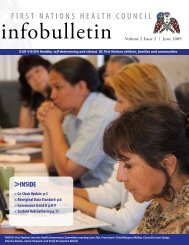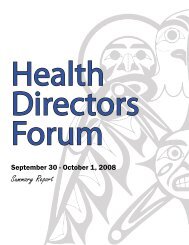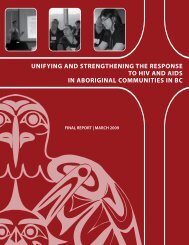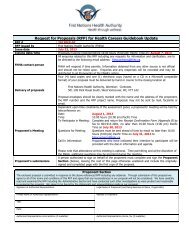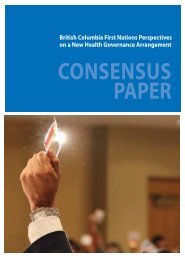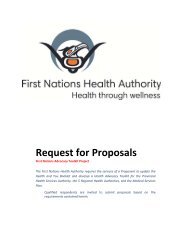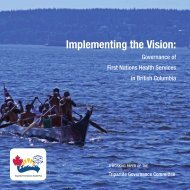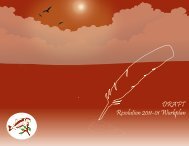pdf download - First Nations Health Council
pdf download - First Nations Health Council
pdf download - First Nations Health Council
Create successful ePaper yourself
Turn your PDF publications into a flip-book with our unique Google optimized e-Paper software.
any event/access (i.e., leisure access card, golf<br />
course access, etc.), lowering gas prices<br />
• Determine what are the Best Practices and<br />
promote them (e.g. How do other <strong>First</strong> <strong>Nations</strong><br />
communities succeed? more training that is<br />
culturally appropriate - e.g. FKC)<br />
• Increase awareness of mainstream funding and<br />
grants<br />
• Provide promotional materials (e.g. brochures,<br />
DVDs, and “cool stuff” for kids)<br />
• A number of ideas suggest the need to develop<br />
a broader strategy around physical activity that<br />
includes:<br />
• famous athletes and speakers in materials (i.e.,<br />
NHL)<br />
• all-native hockey tournament<br />
• women’s soccer players highlighted<br />
• support for organized sport-paid coaches for<br />
soccer and basketball<br />
• update facilities and equipment<br />
• help with wildlife programs<br />
ActNow: Nutrition<br />
Nutrition and physical activity are seen to<br />
go hand in hand in many respects, and this is<br />
particularly true in terms of work within the<br />
Aboriginal Diabetes Initiative. When asked<br />
to provide guidance on how best to promote<br />
healthy eating in <strong>First</strong> <strong>Nations</strong> communities the<br />
participants stressed that it will be important to<br />
address issues and actions in the areas of access,<br />
traditional foods, education/awareness, and school<br />
based approaches:<br />
Access:<br />
• Lack of resources to purchase healthy foods.<br />
• Cost (isolated communities).<br />
• Traditional Food Promotion:<br />
• Seasonal traditional food preparation.<br />
• Researching nutritional value (i.e. Ca2+).<br />
• Food security.<br />
• Food safety preparation (legislation).<br />
• School-based Policies and Promotion:<br />
• <strong>Health</strong>y menu development.<br />
• Serving traditional foods.<br />
• Serving healthy foods.<br />
• Education:<br />
• Small, gradual steps to sustainability.<br />
• multi-media.<br />
• Practical activity sheets.<br />
• Community-based training.<br />
Injury Prevention<br />
The TFNHP sets as one of its goals the<br />
establishment of appropriate programs to assist<br />
<strong>First</strong> <strong>Nations</strong> to deal with the most pressing health<br />
promotion and disease and injury prevention<br />
issues affecting their communities, so that the<br />
incidence of preventable diseases and injuries in<br />
the <strong>First</strong> <strong>Nations</strong> population becomes comparable<br />
to that of other British Columbians. The input<br />
from the 2007 Gathering encouraged that ‘injury<br />
prevention’ be reframed to include a wider<br />
number of injuries than the initial items identified<br />
in the TFNHP. Consistent with that, the participants<br />
at the 2008 Gathering defined effective injury<br />
prevention within a tripartite process in broader<br />
terms focusing on a wide variety of ‘risks’:<br />
Injury prevention is seen to include:<br />
Suicide:<br />
• Alcohol, copycats, bullying, self-harm, intent to<br />
self-injure.<br />
• motor Vehicle:<br />
• Car seat, booster seat, drugs, alcohol.<br />
Alcohol:<br />
• Water safety, domestic violence, family<br />
violence.<br />
• Home Safety:<br />
• Access to cleaning agents, fire, electrical.<br />
Child Safety:<br />
• Young age drinking.<br />
• Trapped in old fridges and cars.<br />
• Playground equipment.<br />
• Bike safety.<br />
Effective Strategies include:<br />
• NAYSPS/ASCIRT/FAST.<br />
• Education.<br />
• media.<br />
• Enforcement.<br />
• Community ownership.<br />
• Holistic approach – include arts, contemporary,<br />
traditional.<br />
• Traditional intergenerational teaching.<br />
• Community based activities such as clean-ups,<br />
and funding workshops.<br />
FNHC can address injury prevention within the<br />
TFNHP by emphasizing:<br />
• Culture.<br />
• Dedicated funding.<br />
• Surveillance.<br />
• Database.<br />
• Getting funding where needed.<br />
• Youth involvement at tripartite level.<br />
• more human resources.<br />
• Offering solutions rather than just presenting<br />
statistics.<br />
• Experiential messages from people who<br />
survived.<br />
• media campaign.<br />
Traditional Medicine<br />
Reduced access to traditional lifestyles, food<br />
and medicine has contributed directly to the<br />
diabetes epidemic in <strong>First</strong> <strong>Nations</strong> communities.<br />
19<br />
VANCOUVER, bC • mAY 20 - 21 , 2008



